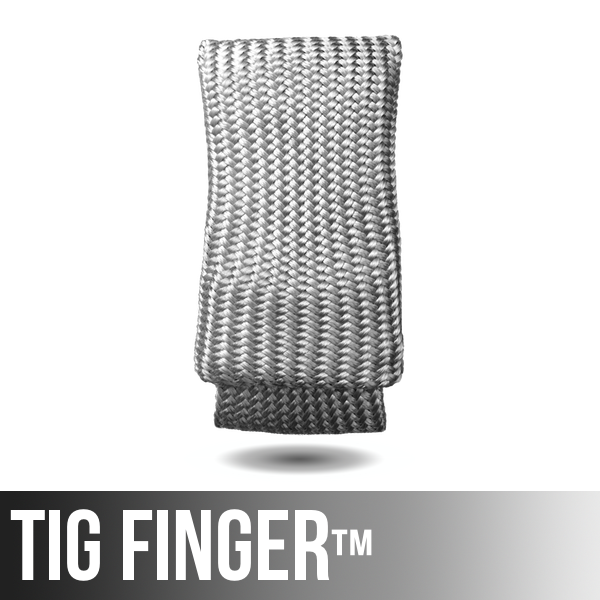Video Transcript
How to TIG Weld Aluminum – Part 2
This is part two in a how to TIG weld aluminum series. In part one, I asked for comments, and I said that the comments are going to sort of determine the direction I go with this and the topics that I cover. Well, I got a lot of them, a whole lot. Like, over 350 comments so far. So I’ve got to figure out how to address that, and I’ve got to get a game plan together.
But meanwhile, I’ll take a few bites out of this elephant today. I’ll talk about AC balance a little bit, a few suggestions on how to to feed filler rod, a little technique I use to kind of avoid duffing the electrode, and a little bit about tungsten electrodes and why I like 2% lanthanated. Let’s dive in.
Here’s a question that was asked a few times. Basically, how you keep a tight arc without dipping the tungsten in the puddle, because it is a struggle. It’s just the puddle … every time you dip the rod in, the puddle kind of grows in height a little bit, and if you don’t compensate for that, a lot of times, you’ll sputter, and molten aluminum will just jump on your electrode.
And I’m going to use this very basic machine. There’s no AC balance adjustment here, and I’m just going to run a bead here just to show you what I do to avoid dipping the tungsten or getting the tungsten contaminated in the puddle. Number one, I pause while I’m dipping rod. I don’t keep the torch moving, typically. And number two, I lengthen the arc just a little bit while I dip rod. The puddle height grows a little bit when you add rod, and so if you lengthen the arc just a little bit … it’s just a very subtle movement. It seems to help me a lot. It works on T-joints, lap joints, you name it.
All right. That was done with a number eight cup, about 15 CFH of pure argon, 2% lanthanated electrode, 3/32 with a slight taper on it. That’s my … kind of my setup for that machine. Aluminum is weak and brittle at certain temperature ranges. It’s known as hot shortness. Basically, it’s … there’s all kinds of scientific names for it.
But you see this cracking here at the beginning of a bead when you weld from the edge, especially on a small piece that heats up quickly. You see the cracking got worse every bead. Barely cracked on the first bead, and by the third bead, it’s cracked a lot. So you’ve got to pay attention to that. This is a much larger piece here that absorbs heat a lot better. You can see I didn’t have that same problem here. I was basically using the same settings. I just didn’t have any cracking here.
All right. What tungsten electrode do you use all around for aluminum parts? Well, I like 2% lanthanated, and I’m going to show you a little example here of 2% lanthanated versus pure at 175 amps. So I’m using the foot pedal. I’m going to start off at a low amperage, but then, I’m going to ramp up to the full 175 amps.
This is pure tungsten, and this is kind of why I don’t like it, because once I get up to full amperage, the tip of that thing is just molten. It’s a ball. It’s quivering. If I were to flick it with the electrode, the whole ball would probably dump into the puddle. And then, when I restart with that big, round tip on there, I don’t get a good, crisp restart. The arc wanders a little bit. So that’s pure tungsten.
And this is 2% lanthanated. They’re the same. Everything’s the same, except I changed the electrode out. It starts off nice and crisp with t point on there, but then, as I ramp up to full amperage, it just founds a little bit on the tip. There’s no quivering ball to worry about. Now, it misshapes a little bit sometimes. It’s not a perfectly spherical ball like that, and so that brings me to the next question.
Do I still ball an electrode with an old transformer machine, or should I use a taper? Well, I use a little bit of a taper on the transformer machine here. But in order to ball it, I flip over to DC plus. That’s EP, and give it just enough amperage to make a nice, rounded tip on there. And then, I switch back to AC, and now, that rounded tip typically will stay stable. It won’t turn into anything different once I round it like that. So that works good for me.
What’s the best setting for AC balance to start with? Well, I’ve got some opinions on this. AC balance is a nice feature to have. It’s not a 100% necessary feature, but very nice to have. What it does … it allows you to adjust the amount of cleaning action in the arc. The more cleaning action you have in an arc, the more the tip of your electrode will heat up.
You can refer to part one for why all of that happens, but the more it heats up … And so sometimes, you have to go to one size larger electrode at a certain level of cleaning action. Well, if you don’t need all of that cleaning action, you can turn the cleaning action down and maybe get by with a smaller electrode. A real good place to start for cleaning action, I think, is 65% EN. Now, some machines list cleaning action as percent cleaning, so that would equal 35%.
If you’re not sure what your machine does, well, set the AC balance all the way one way, weld with it, and then set it all the way the other way and weld with it, and you’ll know pretty quickly. The side that the electrode heats up and melts on the tip a lot more, that’s your percent cleaning.
You don’t always need to use a tapered electrode to pinpoint heat and get a really low arc start or crisp arc start, but sometimes you do, for instance, on a thin lap joint. So being able to set AC balance and have a tapered electrode is a benefit. Now, if I turn the AC balance to roughly 65, I will probably get a little bit of a rounded tip. And if I went down as low as 50, I would get a big rounded tip like this. That’s kind of the difference. That’s what AC balance does, when the more cleaning you add in there.
So this machine goes up to 90% EN and down as low as … only as low as 60% EN. Here’s a bead at 90. This is why I would hardly ever use 90. I don’t know why I would want this. I’ve got oxides floating around in the puddle. It’s not good, not giving me a pretty bead. I picked up oxides right off the start, so I’m going to go down to 80% EN. Still get a little oxide floating around in the puddle, also called pepper in the puddle. Picking it up mostly on the edge, and it’s cleaning up as I get inboard, which tells me I’m probably drawing a little oxygen in on the edge. That does make a difference, too.
Picked a little oxide up right there on the edge, but it cleans up as I get inboard. So I think it’s probably picking up a just a little bit of oxygen on the edge. But when I change it down to 60% EN, which I would probably normally start off at 65, just from experience … of course, I started just a little bit inboard there. But you can see it cleans up really nice. Nice shiny, wet puddle. That’s what I want. Electrode’s not heating up too much, and I’m still maintaining a pretty good taper on the electrode even at 60% EN.
And by the way, I’m at 100 hertz here on the frequency. This machine has frequency adjustment, as well. And I get a nice, clean bead. I’m after a clean bead. I like it clean. I don’t care how much cleaning action and etching there is on the outside. I want a clean puddle.
So far, the only shielding gas I’m using here is argon for this series. Eventually, I’ll get into some helium mixes and some other gases. That changes. The AC balance and how the cleaning action works changes when you start changing gases. So right now, just remember we’re strictly talking about argon.
Another question that was asked more than once was about feeding rod, so I want to show a little … some few little techniques here on feeding rod. It helps sometimes if you can prop your wire feeding hand on the table to stabilize it, and I pinch it with my … between my first two fingers, alternately between my first two fingers and my thumb and my palm. So you’re kind of like alternately pinching and then letting go.
So I pinch it with my first two fingers, and I feed it, and then I let go, and I choke back. And it just requires practice. Honestly, you have to get a rod and sit on the couch while you watch TV, or if you even watch TV, and just practice and try different things. Here’s another method where I’m feeding it with my thumb and my palm, basically, but I’ve got the rod just kind of pinched between my ring finger and my middle finger. And so that part of my hand stays still, and I’m just feeding with sort of pinching it with my thumb and feeding it through those two fingers.
Now, here’s a fellow that we had on the Welding Tips and Tricks podcast. His name is Rush Kane. He’s Kanekid on Instagram. He’s got a very unique way of feeding wire, and I really like it. And actually, if you think about it, for his hand positioning, doing this little positioner weld here, it makes perfect sense. He’s comfortable. He’s got his torch hand propped. He’s got his wire feed hand propped. The angles are right.
He uses that same technique to go along long joints like this, where he just drags one hand along the joint, feeding the wire sort of sideways into the puddle. And it works great for him, and he does a really great job. He welds a lot of aluminum parts, and unfortunately, most of them get sanded and blended off. But he has figured out the right amount of weld to put on something so that there’s minimal grinding. So check him out. He’s Kanekid on Instagram.
All right. The next 45 seconds are a straight up commercial for my latest DVD set. Every year, I take my YouTube videos, I get my son, Jake, to put them on a four disc set. We put them up on our store at weldmonger.com, and that’s what helps me pay for metal and gases for videos.
Let me show you a quick sample of what’s on the 2016 set. There’s some TIG welding aluminum, TIG welding steel, good arc shots, lots of different applications and different jobs done that year. Uphill T-joint with 7018 stick. Dual shield flux core, 3G vertical test, as well as a 4G. 6G, 2 inch schedule 80 pipe with a 6010 root, 7018 fill. Dual shield flux core pipe welding cap with a TIG root at JD shop.
That was just some of the stuff. Here’s a quick look at the four disc set, categorized, nice case. So if you want to up your welding game and you think it might make sense for you to won this DVD set, head over to weldmonger.com. Check it out. Thanks for watching.







Leave a Reply